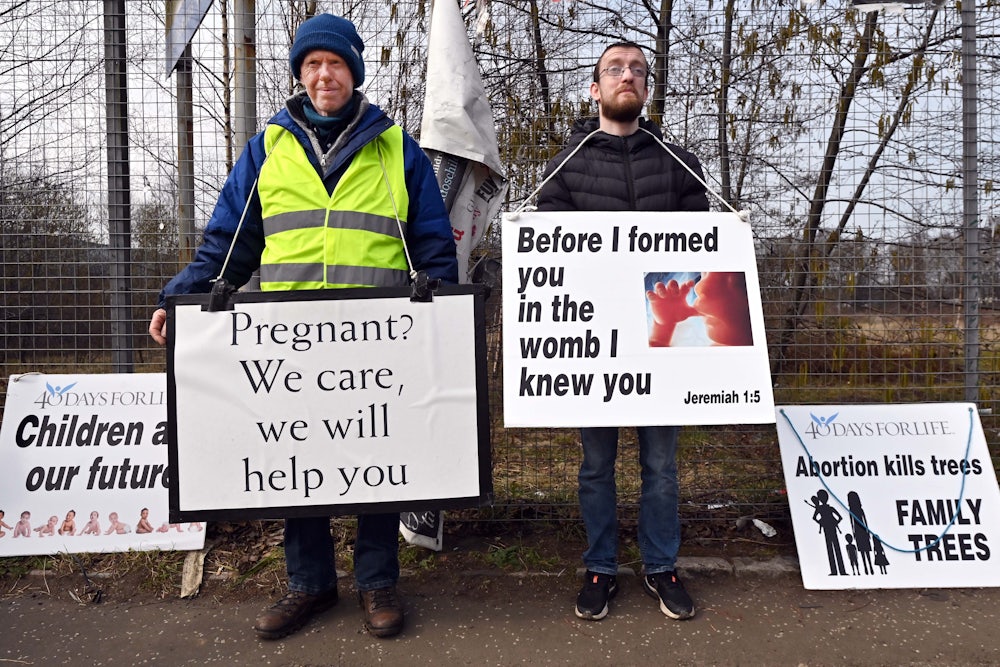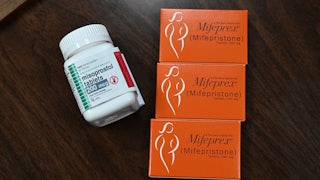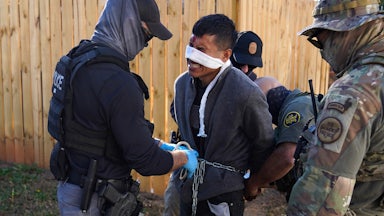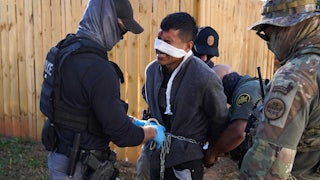There were four or five protesters outside Queen Elizabeth University Hospital in Glasgow, Scotland, the first time Dr. Greg Irwin saw them. He was driving to his job as a consultant radiologist when he noticed the group hoisting placards opposite the parking lot, close to the maternity unit. BEFORE I FORMED YOU IN THE WOMB I KNEW YOU, one sign read, alongside a Bible reference. “Oh, my God,” Irwin thought. “It’s one of those American protests.”
After he parked in his usual spot, an older woman holding rosary beads smiled as he approached. “We’re holding a prayer vigil,” she explained, adding that they were offering “support and advice” to women. Irwin noticed their placards were branded with the logo of 40 Days for Life. When he googled the name later that night, he expected to find a local church organization. Instead, he discovered the shiny, high-budget website of a Texas-based group, emblazoned with pictures of men in sharp suits with dazzling white teeth. A counter in the corner ticked down the numbers of babies “saved” worldwide. Scrolling, he saw a map festooned with red pins, marking group locations all over the world. Irwin stared at his screen, bewildered. How could there be a connection between a group in Texas and the woman outside his hospital in Scotland?
Over the past decade and a half, 40 Days for Life has quietly become one of the most successful anti-abortion organizations in the world. Its 40-day–long continuous clinic pickets—which it prefers to call “vigils”—take place twice yearly, during Lent and again in the run-up to Advent in the fall. It’s brought clinic-targeted activism, which used to be a largely U.S. phenomenon, to over 1,000 cities in 65 countries.
The organization’s founders, Shawn Carney and David Bereit, are two of the most in-demand speakers on the pro-life circuit. Carney, the current CEO, proudly told me the ACLU once called his campaign “the greatest threat to choice because we’re highly organized, and we’re local.” Online you can buy his books, which teach you how to respond to pro-choice arguments and collate “inspiring stories” from the movement, alongside 40 Days for Life–branded t-shirts, caps, and baby onesies. You can enroll in the 40 Days for Life University to learn the most effective ways to dissuade women from abortions, or nominate yourself for one of the yearly awards dished out at flashy galas attended by politicians such as Mike Pence. A weekly podcast hosted by the ever-upbeat Carney means that, even if you live thousands of miles from Texas—say, in a Scottish city—you can stay updated on the latest conservative American talking points.
“We’ve always had some people outside [clinics], but for a long time it would just be a nun or priest praying in the corner,” said Rachael Clarke, chief of staff at the British Pregnancy Advisory Service, or BPAS, a nonprofit commissioned by Britain’s taxpayer-funded National Health Service to run more than 70 women’s health care clinics. However, after 40 Days launched in the U.K. in 2010, “we began to see a switch to tactics copied from the U.S.,” Clarke said. Pam Lowe, a senior lecturer in sociology at the University of Aston, who carried out a five-year study of British anti-abortion movements, said the American organization has given activists in other countries “a structure to follow, and also an infrastructure.” This includes training, materials, and a central management team. Its largest regions are Europe and Latin America, with over 50 campaigns in Colombia alone.
Since Irwin first encountered the group outside his Scottish hospital five years ago, the protests have steadily grown. They now take place almost every Tuesday and have attracted over 100 people at times. It is one of 25 health care premises in the United Kingdom that 40 Days boasts to have targeted.
“For the clinics that are hardest hit, it has a real impact on our ability to provide care,” Clarke said. “Nurses and midwives are spending the first few minutes of the consultation calming women down.” In Latin America, where the protests started around 2014, many health care professionals experience mental health problems “because they are constantly being harassed when they go in and out of the clinic,” said Cristina Rosero, regional legal adviser for the Center for Reproductive Rights.
In Scotland, much of Irwin’s spare time is now taken up campaigning for nationwide buffer zones. In his view, the protests feel judgmental and ominous, even if they just involve praying. “There’s frustration in the hospital,” he said, “because you want them to go away but you can’t do anything.”
40 Days for Life’s origin story is legendary in pro-life circles. I first heard it from Martin, the leader of a local 40 Days group in Reading, an affluent city around an hour’s drive from London. When we spoke in fall 2021 outside his local clinic, he eyed me suspiciously from beneath his wide-brimmed tweed hat. He had been nervous about meeting, because he believes clinic protests have received unfair press in the U.K., and he would only offer his first name.
Martin told me it all started in Bryan, a conservative and deeply religious East Texas college town. A 2003 Texas Monthly article by Pamela Colloff details how the community banded together to drive out the local Planned Parenthood, with landlords and even plumbers unwilling to do business with it. Gloria Feldt, who was then the organization’s CEO, reportedly called Bryan “the most anti-choice place in the country.”
In 2004, local activists Bereit, then a pharmaceutical salesperson, and Carney, a student at Texas A&M, decided to stage a 24-hour prayer vigil for a continuous 40 days. “They came up with the idea of 40 Days because it’s very biblical,” Martin explained, reeling off a list of examples from the holy book, such as the great flood and Jesus’s fasting in the desert.
It was a cold day, and Martin shivered as he talked. In his hands he held pamphlets containing the phone number of a local crisis pregnancy center and warning that abortion causes depression—a scientifically unverified claim. He told me about Abby Johnson, who “had a complete change of heart [and] came over to the other side” after working at the Bryan clinic. According to Johnson’s testimony, she walked into Carney’s office during the middle of the group’s fall 2009 campaign and told him, “I can’t do this anymore,” after watching an abortion being performed on the ultrasound screen.
Johnson immediately became a pro-life sensation, appearing on conservative talk shows and at speaking events. Numerous medical professionals and investigative journalists have questioned her account, but their claims have not dulled her status. A film about her conversion, Unplanned—which Martin suggested I watch—was released in 2020, earning $21,354,152 at the box office, an unusually high figure for a Christian film. “And that clinic did close down, and it became the headquarters for 40 Days for Life,” Martin continued, effortlessly reeling off the timeline. He added that he prays for local clinic workers in the hope they will have their own Johnson-esque turnaround.
Clinic pickets have been a feature of the U.S. anti-abortion movement since its inception. According to historian Jennifer Holland, author of Tiny You: A Western History of the Anti-Abortion Movement, they spread widely in the 1980s thanks to Arizonan John Jakubczyk, who launched Project Jericho, in which different groups took shifts protesting outside the same clinic. “It gave the sense that there was constant picketing, even if it was different people doing it,” she told me. This tight coordination helped it escalate.
In addition to the clear goal of stopping women seeking abortions, these pickets give grassroots activists a sense of empowerment. They also transform public space into religious space. “Common thoroughfares—the route to school, the path to work, the place one parked—were weighed down with promises of salvation and threats of eternal damnation,” Holland writes in Tiny You.
As the pickets spread, the tactics escalated. In the early 1990s, groups such as Operation Rescue invaded clinics and attacked providers, drawing hundreds of volunteers. According to British academic Lowe, a group called Rescue UK launched but was seen by most Christians as too extreme. In France, a wave of similar activities prompted the government to outlaw clinic-based direct action entirely. In the United States, the Clinton administration introduced the Freedom of Access to Clinic Entrances Act, or FACE Act, which made the most aggressive activism illegal. While clinic pickets continued in the United States, they never took off in Europe, because of their association with violence.
Perhaps learning from other groups’ mistakes, 40 Days for Life carefully constructed a more palatable version, centered around prayer. “No one responds to somebody yelling at them,” CEO Shawn Carney told me when we spoke over Zoom. Carney is in his early forties, smartly groomed, and talks with the confident, well-rehearsed flow of someone who’s received a lot of media training. “We’re here for hearts and minds.”
Carney is a Roman Catholic, as are many of the board members and local group leaders, but the campaign is branded as broadly Christian. His flashy marketing and self-promotion seem more in line with the style of evangelical megachurch leaders than the Vatican.
Reframing clinic pickets as prayer vigils not only helps them appeal to less radical Christians, but also places them in a legal gray area where they can be argued as a form of religious expression. Carney emphasized this repeatedly throughout our conversation, calling buffer zones an attack on free speech. However, both clinic workers and patients say prayer itself is a type of harassment. “I don’t think we talk about prayer enough as a hustle tactic,” said Lizz Winstead, founder of Abortion Access Front in the United States. “[It’s] really playing with the emotions of people who are struggling.” Pro-choice activist Alice Murray, who encountered a 40 Days for Life vigil in the Scottish city of Edinburgh in October 2019, told me she felt scared and intimidated, even though the protesters did not approach her directly. “It completely changes your experience of getting an abortion,” she said, describing how she went into fight-or-flight mode, putting one foot in front of the other. “They made it feel dark, in a way.” There are many recorded incidents of 40 Days members engaging in serious harassment. One member in Manchester, England, was issued a restraining order. In the United States, several members have been accused of violations of the FACE Act; in one such recent case in Philadelphia, a 72-year-old clinic volunteer was assaulted, though a jury acquitted the 40 Days for Life member in late January.*
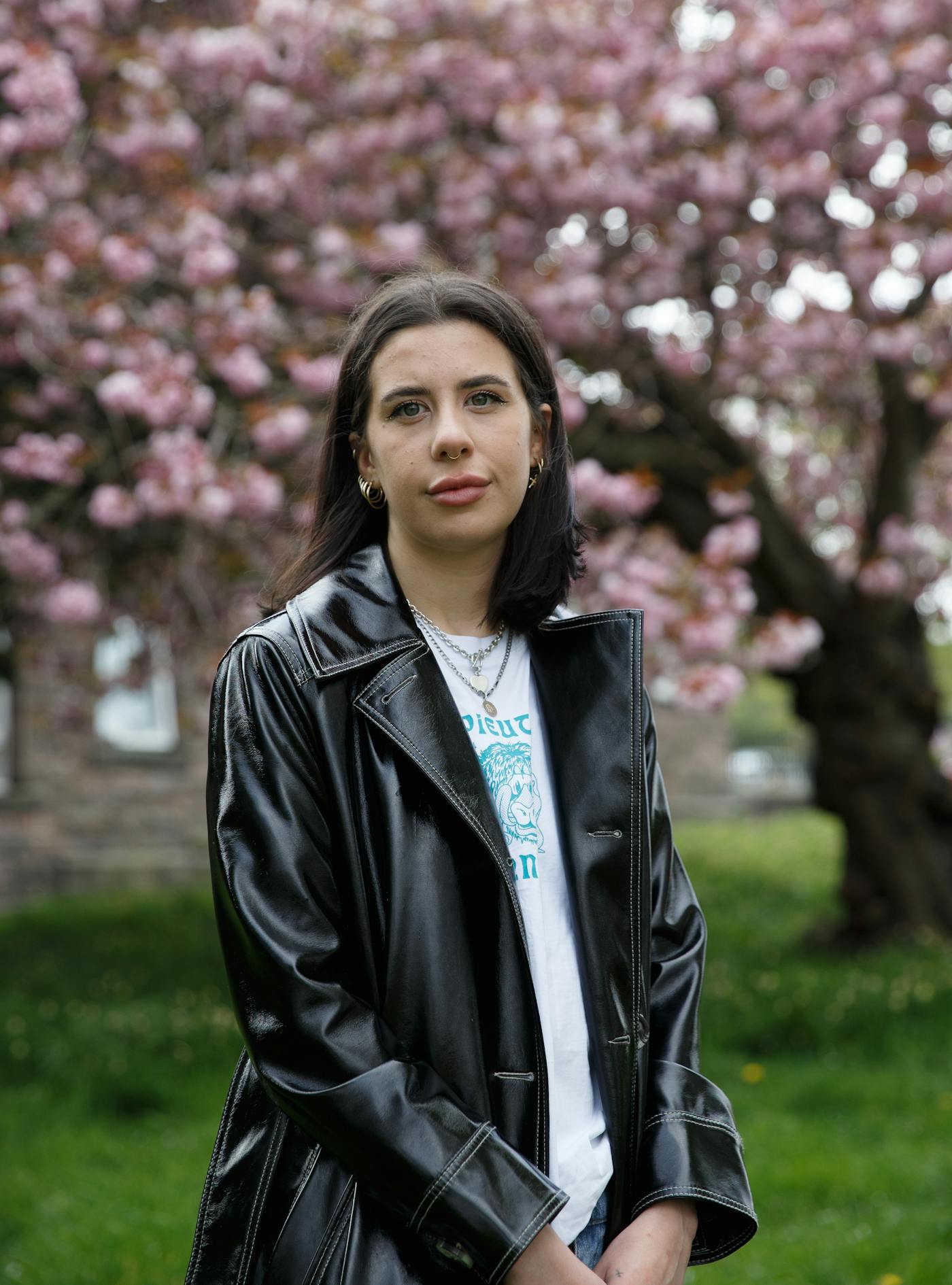
You also don’t have to dig far to find more extreme views and connections. Far-right commentator Matt Walsh, who has supported the racist great replacement theory, wrote the foreword to What to Say When, Carney’s book about answering pro-choice arguments. One podcast episode from 2022 is titled “Why Do Pagans Sacrifice Their Children”—a topic reminiscent of the QAnon conspiracy theory. “I think what gets people in the door is their proclamation of peaceful protest,” said Winstead. “And when they realize that this is not going to stop abortion, they are radicalized to take the next step.”
In 2007, Bereit and Carney took 40 Days for Life national, organizing coordinated vigils in 89 different cities. The movement drew support from powerful players in the American religious right, such as the Knights of Columbus, a Catholic fraternity that bankrolls many anti-abortion and anti-LGBTQ groups, and American Life League. The movement also adopted a model beloved by many U.S. businesses: the franchise. Local leaders pay a fee to join and receive mandatory training in how to run a campaign, recruit volunteers from local churches, and speak to the media. They must also sign a code of conduct.
40 Days for Life soon expanded to Canada. In 2009, British missionary Robert Colquhoun, then 27, spotted a group praying outside the Morgentaler Clinic in Ottawa. Confrontational clinic activism had never appealed to him, he told me over Zoom, but the religious framing seemed like “something new.” Back home the following year, he signed up to lead a local campaign on the group’s website, took the training, then launched the first London campaign outside MSI Reproductive Choices in the capital.
Word spread quickly in the country’s relatively small pro-life community—around 90 percent of Britons identify as pro-choice—and Colquhoun set up more groups around the U.K. The London clinic eventually closed—a fact that was celebrated on 40 Days for Life’s social media as a miracle in “secular London.” However, when asked for comment, MSI told me it moved its abortion services to two other London clinics for reasons unconnected to the protests.
In 2012, the 40 Days for Life HQ in Texas gave Colquhoun a full-time job as director of international campaigns. Carney told me that his organization has never actively recruited in another country. “They have all come to us,” the CEO told me confidently. But Colquhoun contradicted this, saying his job involves finding people to start groups. To date, Colquhoun has traveled to 30 countries promoting 40 Days for Life.
The number of babies “saved” globally is a big part of 40 Days’ marketing—as I write this, the ticker on the website counts 22,829. During campaigns, these figures are repeated across anti-abortion websites and social media. I asked Colquhoun how it’s calculated, and he admitted it is hard to quantify. Local leaders send a feedback form after each campaign, and crisis pregnancy centers report how many women have gotten in touch, but no fact-checking is carried out. I asked if he could put me in touch with women he’s helped, but I’ve yet to hear a response.
The camera focuses in on a woman standing outside the hospital in Split, a picturesque Venetian-built town on the Croatian coast beloved by European vacationers and Instagram influencers. She holds a sign saying: I WANT TO BE WITH YOU, MOM. The video cuts to her speaking directly to the camera. “I know the name of the child, the sex of the child,” she says, recounting her abortion as she fights back tears. “And every time I see a child of the same sex, I ask myself one hundred times what color its eyes would have been.”
The clip is part of a 40-minute–long documentary posted on YouTube by 40 Dana za Život, the Croatian arm of 40 Days for Life. In less than a decade, the organization has built a huge presence in this country of just four million people. For the fall 2022 campaign, there were vigils outside all 40 clinics and hospitals that offer abortion in the country. “There was nothing like it that existed in Croatia prior to that,” Colquhoun told me proudly.
Since the dissolution of socialist Yugoslavia, the Catholic Church has exerted ever-greater power in Croatia’s public institutions. Religious discourse took a particularly conservative turn in 2013, during a referendum on same-sex marriage. The vote deeply divided the country and gave momentum to anti-feminist and anti-LGBTQ organizations.
The first 40 Days for Life Croatia campaign took place the following year. Maja Gergorić, a political scientist at the University of Zagreb who researches ultraconservative movements, said local churches were already organizing large groups of volunteers. “This made it easy for them to mobilize for something else straight afterwards,” she said. Other American-inspired pro-life initiatives have also flourished, such as the March for Life, which takes place in 11 cities, and “memorials to the unborn” in six public cemeteries.
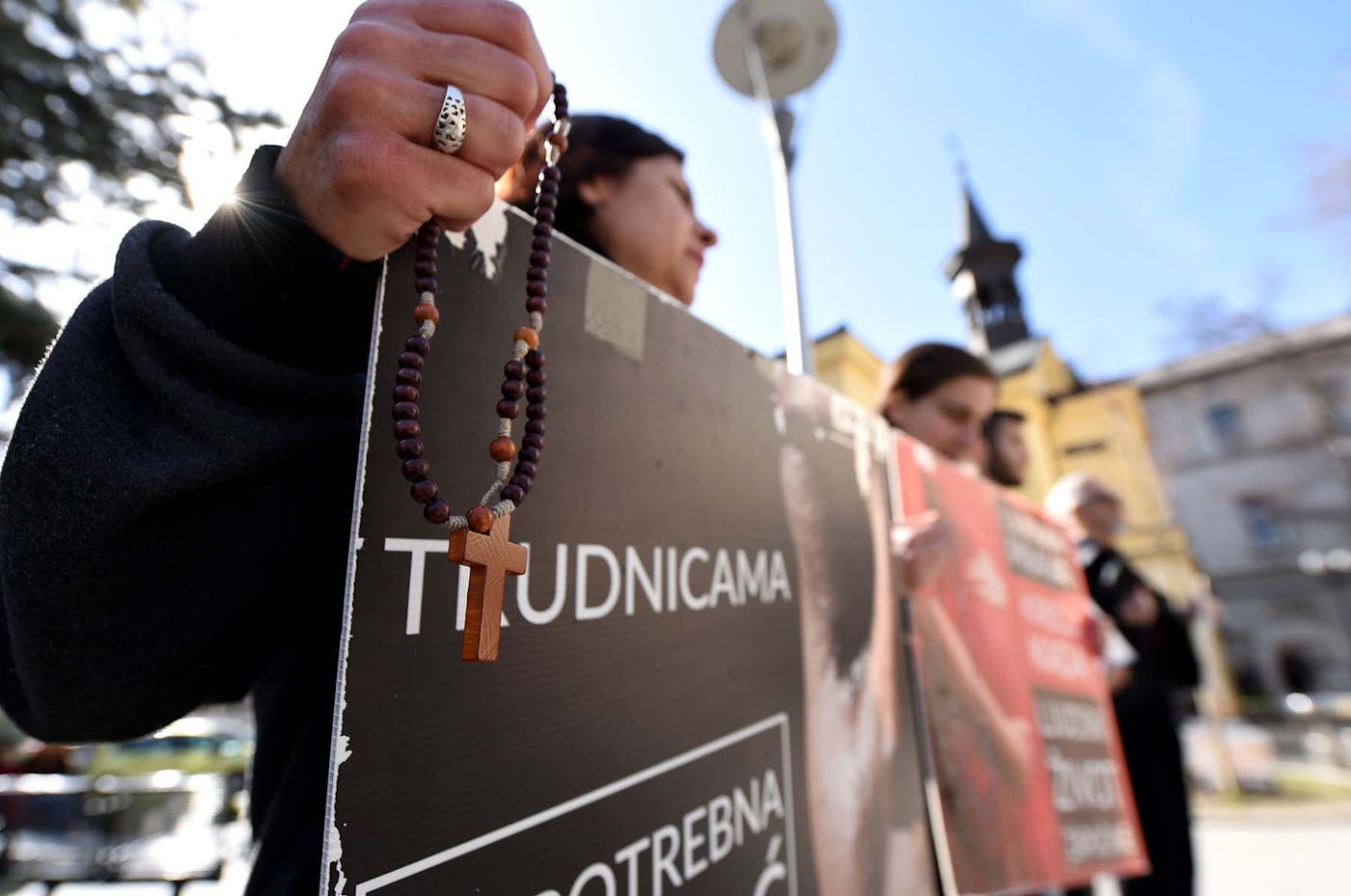
At the Church of Saint Anthony of Padua, west of Zagreb’s city center, I met Friar Ivan Marija Lotar. His parish is partnered with 40 Days for Life, and the group’s regional leaders regularly give speeches after Mass. “I had a couple of friends who were volunteering with them, and they asked if they could come and speak,” he explained. Friar Lotar said his community is seeing “the fruits” of the campaign. “When you know there is a solution other than abortion,” he said, “I think most women will choose that.”
Not everyone agrees. After a 30-minute walk north, I met gynecologist Jasenka Grujić, a vibrant 71-year-old with a silver pixie crop and bright red lipstick. “If a woman really wants to terminate a pregnancy, then she will terminate it,” she told me. Over the past two decades, she has seen the stigma around abortion grow stronger “every day.” She rolled her eyes when I mentioned the vigils, saying they increase this shame, “not just towards those going for an abortion, but to any woman who has ever had an abortion, and any woman who takes contraception.”
Other factors are making it harder to access terminations, even though 73 percent of the public support abortion in at least some circumstances. This includes an increase in the numbers of doctors refusing for religious reasons to perform them. Huge protests broke out in May 2022, when a woman whose fetus had serious abnormalities was refused a termination. Grujić, who is not licensed to perform abortions herself, advises her clients to go to neighboring Slovenia where there are fewer barriers to access.
In early September, Carney walked onstage at a March for Life rally in London’s Parliament Square. “Greetings from an abortion-free Texas!” he began, as a cheer went up. “If we can do it, you can do it!” Taking aim at buffer zones legislation, he shouted to the crowd: “You have to hold on to your freedom of speech—or Europe is finished!”
Through its expansion, Carney’s organization has built links with powerful figures on the Eastern European right. Its new executive director of international affairs, Tomislav Čunović, is a founder of Ordo Iuris Croatia—the local branch of the ultraconservative Catholic legal organization that drafted Poland’s anti-abortion laws. “For some of these groups, Europe is an important frontier, because they see it as a place where secularism has triumphed,” said Mathew Schmalz, professor of religious studies at College of the Holy Cross in Worcester, Massachusetts.
Conservative Christians around the world are drawing inspiration from the overturning of Roe v. Wade. However, the news from the United States is also having the opposite effect—many international politicians are now rushing to protect abortion rights with a renewed urgency.
Back in Scotland, the protesters still gather every Tuesday outside Irwin’s hospital. But their time may be drawing to a close. The Scottish government has announced its commitment to introducing buffer zones, although the law is still under consultation. Politicians in England and Wales have also backed similar plans. Restrictions are expected to be introduced in 2023 and would extend 150 meters around clinics. Protesters could face six months in jail for violations. Carney is outraged at what he sees as a fundamental attack on free speech and said he planned to visit the country to challenge the law, although he would not give details.
In Croatia, the prospect of similar legislation feels a long way off. But pro-choicers are following the news of how other countries have fought back and are taking hope. “This is not only a question of abortion, this is a question of all women’s freedoms,” said Grujić. “They want to reduce our freedoms. But I don’t know if it is possible. I hope it will not be possible.”
* This story has been updated.
This reporting was supported by the International Women’s Media Foundation’s Howard G. Buffett Fund for Women Journalists.
